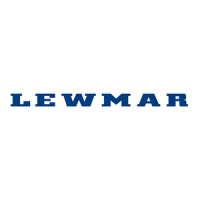Lewmar V1-6 & SPORT Windlass | 20
5.3 Hose types
For reliable operation and safety it is
essential to use reinforced braid hose
for connecting to the motor A and B
ports which conforms to SAE100R2A or
DIN 20 021 Part 2.
The recommended hose sizes are:
• Up to 30 l/min +
1
/
2
” (13 mm) bore
diameter.
• Up to 40 l/min +
5
/
8
” (16 mm) bore
diameter.
• Up to 57 l/min +
3
/
4
” (19 mm) bore
diameter.
• Ref: 3.78 litres = 1 US gallon
4.54 litres = 1 Imperial gallon
5.4 Motor ports - standard
motor/gearbox
The location of the ports for the
standard motor/gearbox is shown in
Fig 5.4-1 (no drain connection).
• The Lewmar hydraulic motor ports
are: A & B ports ½” BSP.
• NOTE: Refer to your installed
hydraulic system manual for
hydraulic drives.
5. Hydraulic System
Fig 5.1-1
Standard Motor/gearbox Fig 5.4-1
5.1 Installation
• NOTE: Hydraulic system installation
is NOT covered in this publication.
Lewmar hydraulic windlasses have
been designed for ease of installation
and follow a straightforward hydraulic
and mechanical installation procedure.
Windlass unit should be connected to
a hydraulic powerpack with directional
control valve installed to control the
windlass movement.
Fig 5.1-1 shows a typical hydraulic
circuit for a V6 windlass.
The purpose of this manual is to
provide the reader with suffi cient
information to install and operate
a hydraulic windlass. It assumes
the reader will be familiar with
sailing craft, marine hydraulics and
mechanical installation and safety
requirements. If in any doubt consult a
qualifi ed marine engineer.
• The installation of hydraulic systems
requires a high level of cleanliness.
The ingress of dirt will dangerously
impair the safe operation of the
system and cause premature wear of
hydraulic components.
5.2 Hydraulic motor/gearbox
The hydraulic motor/gearbox consists
of a high torque hydraulic motor fi tted
to a 7:1 90 degree gearbox.
The hydraulic motors have a maximum
pressure rating of 180 bar and can be
used with an oil supply of up to 57 l/min.
The motor gearboxes are not self
sustaining. A dual Pilot Operated
Check Valve (POCV) must be installed
in the system to temporarily sustain
any load. The POCV can be line
mounted (as shown in Fig 5.1-1) or
modular type if for example a CETOP 3
directional valve is being used.
• NOTE: To permanently sustain a load
a Chain Stopper must be used.
WARNING!

